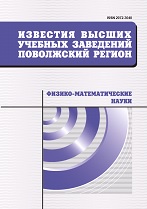|
This article is cited in 1 scientific paper (total in 1 paper)
Quantum-dimensional insulators
R. A. Brazwe
Ulyanovsk State Technical University, Ulyanovsk
Abstract:
Background. Controlled phase transitions of the metal -insulator type, caused by some form of localization of free charge carriers in a limited area of space, are of considerable interest from the point of view of the possibilities of creating various switches, relays, logic elements and other electronic components. The purpose of the work is to study the possibilities of quantum-dimensional transition of metallic graphene nanoribbons and carbon nanotubes into ordinary (non-topological) two-dimensional insulators that do not have edge states of electrical conductivity. Materials and methods. The objects of the study were “zigzag” graphene nanoribbons and “armchair” carbon nanotubes having metallic properties. The work used well-known analytical methods of quantum physics and the band theory of a solid state in relation to nanoscale 2D crystal structures. Results. It is shown that the phase transition of these nanoconductors into insulators is observed when their transverse dimensions are smaller than a certain critical value. At temperatures close to room temperature, this value is 5.0 nm for graphene nanoribbon, and 3.2 nm for carbon nanotube. Conclusions. The ability of ultra-narrow “zigzag” graphene nanoribbons to transition into the state of a quantum-dimensional semiconductor and even a dielectric makes it possible to create a completely new class of superminiature, high-speed devices for nanoelectronics, nanophotonics and nanocomputing. Operating in the ballistic current mode at room temperature, they will not require cooling, but they will differ in low power consumption, the ability to easily integrate into two-dimensional electronic circuits with a high density of layout.
Keywords:
graphene, carbon nanotube, quantum-dimensional effects, metal, semiconductor, dielectric.
Citation:
R. A. Brazwe, “Quantum-dimensional insulators”, University proceedings. Volga region. Physical and mathematical sciences, 2023, no. 1, 115–127
Linking options:
https://www.mathnet.ru/eng/ivpnz527 https://www.mathnet.ru/eng/ivpnz/y2023/i1/p115
|

| Statistics & downloads: |
| Abstract page: | 19 | | Full-text PDF : | 9 | | References: | 5 |
|




 Contact us:
Contact us: Terms of Use
Terms of Use
 Registration to the website
Registration to the website Logotypes
Logotypes







 Citation in format
Citation in format 
